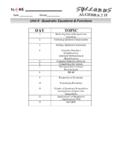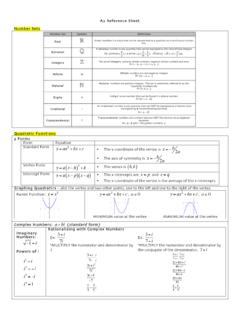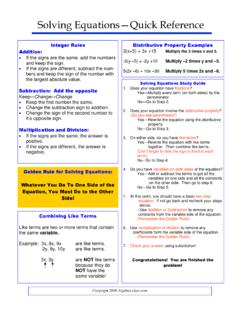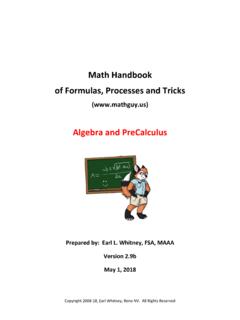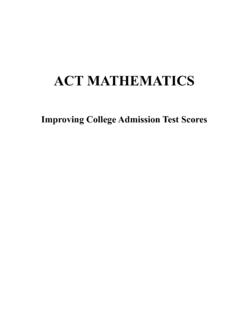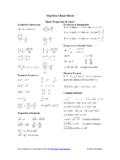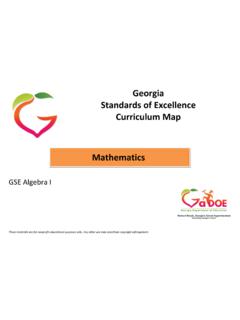Transcription of Trigonometry - mecmath
1 TRIGONOMETRYMICHAEL CORRALT rigonometryMichael CorralSchoolcraft CollegeAbout the author:Michael Corral is an Adjunct Faculty member of the Department ofMathematics atSchoolcraft College. He received a in Mathematics from the University of Californiaat Berkeley, and received an in Mathematics and an in Industrial & OperationsEngineering from the University of text was typeset in LATEX with theKOMA-Scriptbundle, using the GNU Emacstext editor on a Fedora Linux system. The graphics were created using TikZ and 2009 Michael is granted to copy, distribute and/or modify this document under the terms of theGNU Free Documentation License, Version or any later version published by the FreeSoftware Foundation; with no Invariant Sections, no Front-Cover Texts, and no Back-CoverTexts. A copy of the license is included in the section entitled GNU Free DocumentationLicense.
2 PrefaceThis book covers elementary Trigonometry . It is suitable for a one-semester course at thecollege level, though it could also be used in high schools. The prerequisites are high schoolalgebra and book basically consists of my lecture notes from teaching Trigonometry at SchoolcraftCollege over several years, expanded with some exercises. There are exercises at the endof each section. I have tried to include some more challengingproblems, with hints whenI felt those were needed. An average student should be able to do most of the and hints to many of the odd-numbered and some of the even-numbered exercisesare provided in Appendix text probably has a more geometric feel to it than most current Trigonometry was, in fact, one of the reasons I wanted to write this book. I think that approaching thesubject with too much of an analytic emphasis is a bit confusingto students.
3 It makes muchof the material appear unmotivated. This book starts with the old-fashioned right triangleapproach to the trigonometric functions, which is more intuitive for students to my experience, presenting the definitions of the trigonometric functions and then im-mediately jumping into proving identities is too much of a detour from geometry to analysisfor most students. So this book presents material in a very different order than most bookstoday. For example, after starting with the right triangle definitions and some applications,general (oblique) triangles are presented. That seems like a more natural progression oftopics, instead of leaving general triangles until the end asis usually the goal of this book is a bit different, too. Instead of takingthe (doomed) approach thatstudents have to be shown that Trigonometry is relevant to their everyday lives (whichinevitably comes off as artificial), this book has a differentmindset:preparing studentsto use Trigonometry as it is used in other courses.
4 Virtually no students will ever in their everyday life figure out the height of a tree with a protractor or determine the angularspeed of a Ferris wheel. Students are far more likely to need Trigonometry in other courses( engineering, physics). I think that math instructors have a duty to prepare studentsfor Chapter 5 students are asked to use the free open-source software Gnuplot to graphsome functions. However, any program can be used for those exercises, as long as it producesaccurate graphs. Appendix B contains a brief tutorial on are a few exercises that require the student to write his or her own computer pro-gram to solve some numerical computation problems. There are afew code samples in Chap-ter 6, written in the Java and Python programming languages, hopefully sufficiently clearso that the reader can figure out what is being done even without knowing those and Sage are also mentioned.
5 This book probably discussesnumerical issues morethan most texts at this level ( the numerical instability of Heron s formula for the areaof a triangle, the secant method for solving trigonometric equations). Numerical methodsprobably should have been emphasized even more in the text, since it is rare when even amoderately complicated trigonometric equation can be solvedwith elementary methods, andsince mathematical software is so readily wanted to keep this book as brief as possible. Someone once joked that trigonometryis two weeks of material spread out over a full semester, and I think that there is sometruth to that. However, some decisions had to be made on what material to leave out. I hadplanned to include sections on vectors, spherical Trigonometry - a subject which has basicallyvanished from Trigonometry texts in the last few decades (why?)
6 - and a few other topics,but decided against it. The hardest decision was to exclude Paul Rider s clever geometricproof of the Law of Tangents without using any sum-to-product identities, though I do givea reference to book is released under the GNU Free Documentation License (GFDL), which allowsothers to not only copy and distribute the book but also to modifyit. For more details, seethe included copy of the GFDL. So that there is no ambiguity on thismatter, anyone canmake as many copies of this book as desired and distribute it as desired, without needingmy permission. The PDF version will always be freely available to the public at no cost ( ). Feel free to contact me questions on this or any other matter involving the book ( comments, suggestions,corrections, etc). I welcome your 2009 MICHAELCORRALL ivonia, MichiganContentsPrefaceiii1 Right Triangle Angles.
7 Trigonometric Functions of an Acute Angle .. Applications and Solving Right Triangles .. Trigonometric Functions of Any Angle .. Rotations and Reflections of Angles .. 322 General The Law of Sines .. The Law of Cosines .. The Law of Tangents .. The Area of a Triangle .. Circumscribed and Inscribed Circles .. Basic Trigonometric Identities .. Sum and Difference Formulas .. Double-Angle and Half-Angle Formulas .. Other Identities .. 824 Radian Radians and Degrees .. Arc Length .. Area of a Sector .. Circular Motion: Linear and Angular Speed .. 1005 Graphing and Inverse Graphing the Trigonometric Functions .. Properties of Graphs of Trigonometric Functions .. Inverse Trigonometric Functions .. 1206 Additional Solving Trigonometric Equations.
8 Numerical Methods in Trigonometry .. Complex Numbers .. Polar Coordinates .. 146 Appendix A: Answers and Hints to Selected Exercises152 Appendix B: Graphing with Gnuplot155 GNU Free Documentation License160 History168 Index1691 Right Triangle TrigonometryTrigonometry is the study of the relations between the sides andangles of triangles. Theword Trigonometry is derived from the Greek wordstrigono( o), meaning triangle ,andmetro( ), meaning measure . Though the ancient Greeks, such as Hipparchusand Ptolemy, used Trigonometry in their study of astronomy between roughly , its history is much older. For example, the Egyptian scribeAhmes recorded some rudi-mentary trigonometric calculations (concerning ratios ofsides of pyramids) in the famousRhind Papyrus sometime around is distinguished from elementary geometry in part by its extensive use ofcertain functions of angles, known as thetrigonometric functions.
9 Before discussing thosefunctions, we will review some basic terminology about AnglesRecall the following definitions from elementary geometry:(a)An angle isacuteif it is between 0 and 90 .(b)An angle is aright angleif it equals 90 .(c)An angle isobtuseif it is between 90 and 180 .(d)An angle is astraight angleif it equals 180 .(a)acute angle(b)right angle(c)obtuse angle(d)straight angleFigure of anglesIn elementary geometry, angles are always considered to be positive and not larger than360 . For now we will only consider such following definitions will be usedthroughout the text:1 Ahmes claimed that he copied the papyrus from a work that may date as far back as in the text we will discuss negative angles and angles larger than 360 .12 Chapter 1 Right Triangle Trigonometry (a)Two acute angles arecomplementaryif their sum equals 90.
10 In other words, if 0 A, B 90 then Aand Bare complementary if A+ B=90 .(b)Two angles between 0 and 180 aresupplementaryif their sum equals 180 . In otherwords, if 0 A, B 180 then Aand Bare supplementary if A+ B=180 .(c)Two angles between 0 and 360 areconjugate(orexplementary) if their sum equals360 . In other words, if 0 A, B 360 then Aand Bare conjugate if A+ B=360 . A B(a)complementary A B(b)supplementary A B(c)conjugateFigure of pairs of anglesInstead of using the angle notation Ato denote an angle, we will sometimes use just acapital letter by itself ( ,B,C) or a lowercase variable name ( ,y,t). It is alsocommon to use letters (either uppercase or lowercase) from the Greek alphabet, shown inthe table below, to represent angles:Table The Greek alphabetLetters NameLetters NameLetters NameA alphaI iotaP rhoB betaK kappa sigma gamma lambdaT tau deltaM mu upsilonE epsilonN nu phiZ zeta xiX chiH etaOoomicron psi theta pi omegaIn elementary geometry you learned that the sum of the anglesin a triangle equals 180 ,and that anisosceles triangleis a triangle with two sides of equal length.



